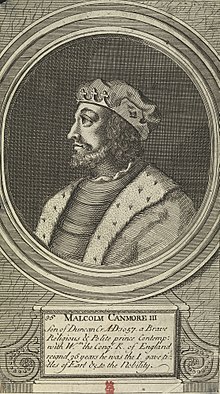Malcolm III of Scotland
One of Malcolm's primary achievements was to secure the position of the lineage that ruled Scotland until the late thirteenth century,[4] although his role as founder of a dynasty has more to do with the propaganda of his descendants than with history.One Scottish king-list gives Malcolm's mother the name Suthen (Suthain), a Gaelic name;[7] John of Fordun states that Malcolm's mother was a "blood relative" (consanguinea) of the Danish earl Siward,[8][9] though this may be a late attempt to deepen the Scottish royal family's links to the earldom of Northampton (of which Siward was regarded as founder).[19] An English invasion in 1054, with Siward, Earl of Northumbria in command, had as its goal the installation of one "Máel Coluim, son of the king of the Cumbrians".Duncan argued in 2002 that, using the Anglo-Saxon Chronicle entry as their source, later writers innocently misidentified "Máel Coluim" with the later Scottish king of the same name.[23] Duncan's argument has been supported by several subsequent historians specialising in the era, such as Richard Oram, Dauvit Broun and Alex Woolf.[30] If Orderic Vitalis is to be relied upon, in the time of Edward the Confessor Malcolm was betrothed to the English king's kinswoman Margaret, and it is possible this happened when he visited England in 1059.[32] It was common practice in medieval Gaelic-speaking societies for kings to launch an invasion, the so-called crech ríg, of a neighbour soon after taking power, and the Lindisfarne raid may have been used to boost the stability of the new regime.[36] A tradition in the thirteenth-century Orkneyinga saga related that Malcolm married the widow of Thorfinn Sigurdsson, Ingibiorg, a daughter of Finn Arnesson.[40] Similarly, however, the importance of the MacWilliams to the earls of Orkney around 1200 would have provided an incentive to strengthen the historical ties between the two families, and thus Ingibiorg's marriage to Malcolm may have been created for the purpose of fabricating common descent.[44] Malcolm appears to have enjoyed a peaceful relationship with the Earldom of Orkney, ruled jointly by his possible stepsons, Paul and Erlend Thorfinnsson.Even though Gospatric and Siward's son Waltheof submitted by the end of the year, the arrival of a Danish army under Sweyn Estridsson seemed to ensure that William's position remained weak.Malcolm decided on war and took his army south into Cumbria and across the Pennines, wasting Teesdale and Cleveland then marching north, loaded with loot, to Wearmouth, now part of the City of Sunderland.The same was true of Malcolm; his agreement with the English king was followed by further raids into Northumbria, which led to further trouble in the earldom and the killing of Bishop Walcher at Gateshead.Based on the idea that the Scots controlled much of modern Cumbria, it had been supposed that William Rufus's new castle at Carlisle and his settlement of English peasants in the surrounds was the cause.And soon after he came home, he gathered his army, and came harrowing into England with more hostility than behoved him ...[60]Malcolm was accompanied by Edward, his eldest son by Margaret and probable heir-designate (or tánaiste), and by Edgar.[68] The remains of Margaret and her husband were removed from Dunfermline by Abbot George Durie to safeguard them from the attacks of Protestant reformers; initially they went to the rural estate at Craigluscar then abroad, and by 1580 they were enshrined at the instigation of king Philip II of Spain in the royal monastery of St Lawrence near Madrid, San Lorenzo de El Escorial, where they remain.



King of Alba (Scotland)CoronationPerth and KinrossLulachDonald IIIAlnmouthDunfermline AbbeyTynemouth PrioryIngibiorg FinnsdottirMargaret of WessexDuncan II, King of ScotlandEdmundEthelred, Abbot of DunkeldEdgar, King of ScotlandAlexander I, King of ScotlandDavid I, King of ScotlandMatilda, Queen of EnglandMary, Countess of BoulogneDunkeldDuncan I of ScotlandMiddle IrishScottish GaelicKing of AlbaScoto-NormanHenry I of EnglandEustace III, Count of BoulogneEmpress MatildaWilliam AdelinMatilda I, Countess of BoulogneScotlandRiver OykelScandinavianFirth of Forthkingdom of StrathclydeBamburghEnglish territorya major characterWilliam ShakespeareMacbethMargaretScotland in the High Middle AgesDuncan IMalcolm IIJohn of FordunSiwardForteviotDonaldKingdom of EnglandEdward the ConfessorThorfinn SigurdssonEarl of OrkneySiward, Earl of NorthumbriaMáel Coluim, son of the king of the CumbriansWilliam of MalmesburyA.A.M. DuncanAnglo-Saxon ChronicleRichard OramDauvit BrounOwain FoelStrathclydeLumphananAberdeenshireHuntlyOrderic VitalisLindisfarnerulers of Bamburghealdorman of NorthumbriaTostig Godwinsonpilgrimage to RomeGospatricEadwulfingOrkneyinga sagaIngibiorgFinn ArnessonDuncanMacWilliamsHeimskringlaHarald Hardradaking of NorwaySweyn Estridssonking of DenmarkEarldom of OrkneyPaul and Erlend ThorfinnssonMagnus Barefootbattle of Stamford BridgeWilliam of NormandyAgathaEdward the ExileEdgar ÆthelingCristinaearl of BamburghWaltheofCumbriaPenninesTeesdaleClevelandWearmouthCity of SunderlandDanegeldWilliam's scorched earth policy against the northern English rebelsEdmund IronsideEthelredEthelred the UnreadyAlexander I of ScotlandPope Alexander IIAlexander the GreatDavid I of ScotlandEustace III of BoulogneHarrying of the NorthAbernethyWalcherGatesheadRobert CurthoseMáel SnechtaiWilliam RufusNewcastleNew CastleRiver TweedRiver TeesNormandycastle at CarlisleGloucesterWilton AbbeyRobert de MowbrayEarl of NorthumbriaAlnwick